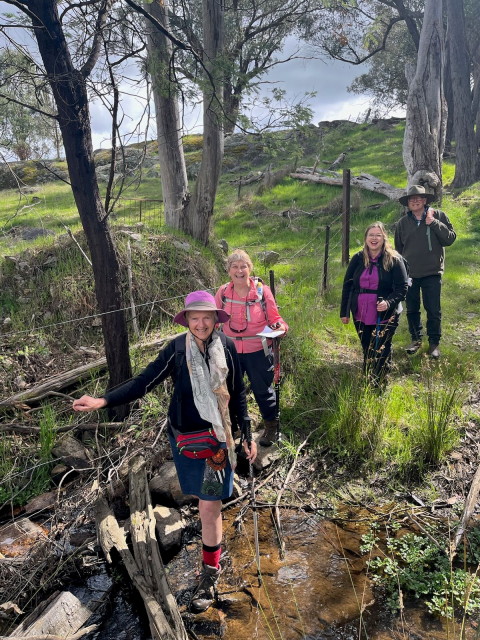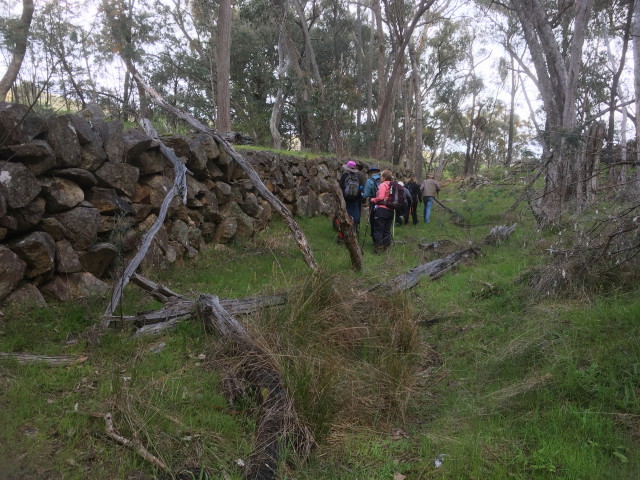Eight walkers (including one visitor) met at Wooragee for this walk, with time being saved by Lesley, Rod and Gerri having organised the car shuffle in advance.
From Wooragee we drove to Pieter’s property, where we were shown a very old Aboriginal Ring Tree with three rings.
We came across a wombat whilst enroute to the Magpie Creek Historic Area and the Magpie Creek Gold Mining Diversion Sluice.
The stone retaining wall here was built by Chinese miners from local granite blocks in the 1860s; the wall and alluvial workings being listed as significant on the Victorian Heritage Database.
Pieter was able to explain the function of the wall, which was to divert the creek away from the bedrock so the miners had better access to the alluvial gold. Whilst hearing about the back breaking work that the Chinese miners did, a koala scaled a nearby tree to see what was going on.
We returned with Pieter along Magpie Creek, and then Jeanette took over as our fearless leader. We had our morning tea overlooking the serene Chinamen’s Dam, and then headed south along the reserve, until we came to a small waterfall where we had our lunch.
From here, it was only a short walk to the southern end of the Historic Area, where the cars awaited our return.
We then returned to Wooragee, and enjoyed afternoon tea at the park area near the CFA building.
Once again, a shortish walk (about six kilometres), which provided us with an informative observation of alluvial gold mining undertaken by Chinese miners in Wooragee from the mid 1860s.
Thanks to Pieter for his generosity of time and knowledge.
[Gerri Boland]
Here are the notes from the Heritage Victoria website.
MAGPIE CREEK ALLUVIAL WORKINGS – Heritage Inventory Description
The Magpie Creek workings feature a complex system of water diversions, deep channels, large dams, stone diversion walls, as well as shafts with mullock heaps, and high sluiced faces.
Heritage Inventory Significance: National Estate. The Magpie Creek Gold Mining Diversion Sluice consists of a 200 metre long stone embankment which was probably built in the mid 1860s when the site was extensively reworked by Chinese miners. The embankment was used to divert the waters of Magpie Creek away from its natural bed which was then mined for its alluvial gold.
The Magpie Creek Gold Mining Diversion Sluice is of historical, archaeological and scientific importance to the State of Victoria. The Magpie Creek Gold Mining Diversion Sluice is historically and scientifically important as a characteristic and well preserved example of an early form of gold mining.
Gold mining sites are of crucial importance for the pivotal role they have played since 1851 in the development of Victoria. Water diversion and sluicing are important key ingredients in an understanding of gold mining technology as it was employed in mountainous country where water was plentiful and perennial.
The Magpie Creek Gold Mining Diversion Sluice is archaeologically important for its potential to yield artefacts and evidence which will be able to provide significant information about the cultural history of gold mining and the gold seekers themselves.
Heritage Inventory Key Components: Creek diversion – The stone-retained (local granite blocks) section of the diversion channel is approximately 200 m long and its walls are 1.5 m high. Water now runs only though the diversion channel. At the southern end of the sluice is an extensive dump of pebbles and wash. A water race takes off from the northern end of the sluice. The sluicing complex is completely free of blackberries.
Dredged landscape – The southern part of the Historic Reserve has been sluiced and dredged and presents a confusing and overgrown landscape of dredge holes, slum ponds and disturbed ground.
MAGPIE CREEK ALLUVIAL WORKINGS – History
Heritage Inventory History of Site:
The Magpie Creek diggings were opened in 1856. In 1864, about 150 Chinese rushed Magpie Creek, all engaging in surfacing and sinking.
More than 150 Chinese miners remained in exclusive occupation of the alluvial ground at Magpie Creek until at least 1867.
Memorably, they were joined by a lone European miner for a short time in early 1866. Many claims yielded as much as 30 to 40 oz per week that winter.
In 1887, Dunn wrote:
“In the valley of Magpie Creek there is an extensive deposit of shingle over the wash-dirt. For over twenty years a large party of Chinese have been working the lead.
They are now sluicing away the whole of the drift, and if it proves payable there is ground enough for another 30 years’ work.”
The New Wooragee Sluicing Co. operated a sand pump in the Wooragee area, possibly extending to Magpie Creek, during the first ten years of this century.


